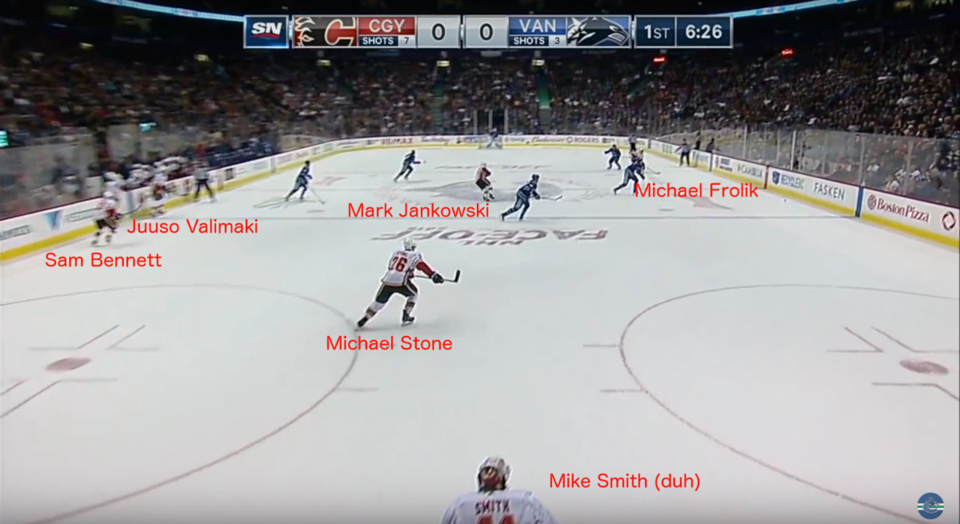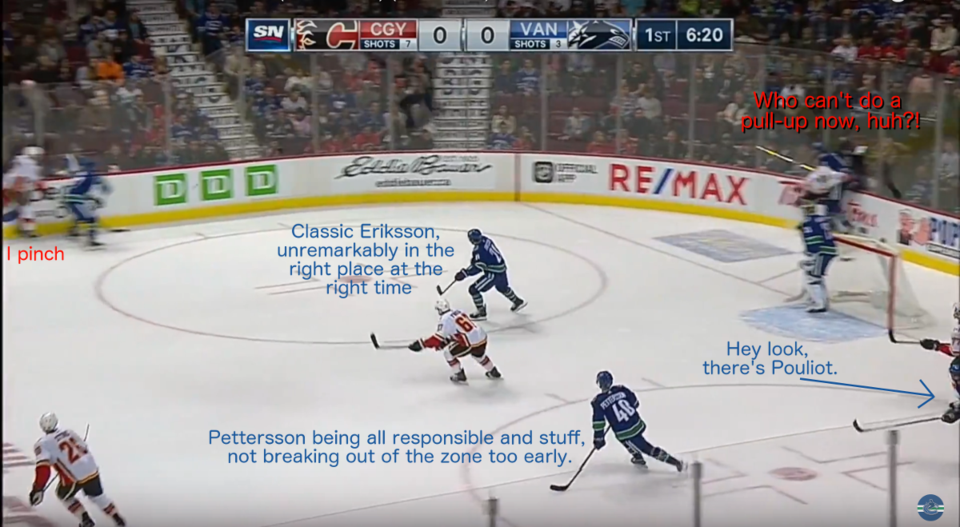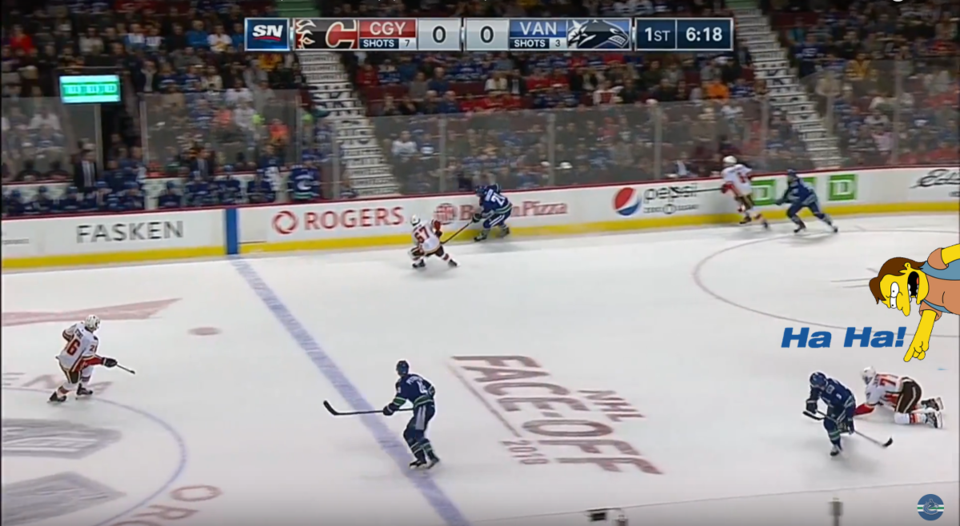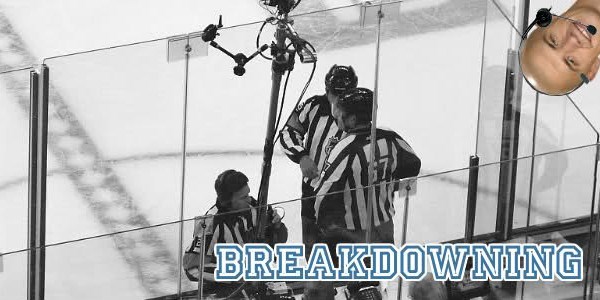That might have been the best debut for a Canucks rookie in franchise history. You could make an argument for Thomas Gradin, who had two goals and an assist in his first NHL game, but that was against the awful Colorado Rockies and it was in an 8-2 drubbing. It’s not quite the same as opening the scoring with your first career shot against a tough Pacific Division rival.
Heck, Pavel Bure didn’t even score in his first NHL game, though he certainly brought Canucks fans out of their seats with his daring dashes up the ice.
Pettersson’s first career goal deserves a closer look and, here at PITB, when we want to take a closer look, we break things down in a feature we like to call “Breakdowning.”
Pettersson’s goal was more than just an elite young forward doing what he does best. It was also the perfect illustration of a well-executed breakout, taking a hit to make a play, and giving the green light to defencemen to jump up in the rush.

I chose the video from YouTube account GoCanucksGo (you can see their watermark in the bottom right corner of the screenshots), as it’s the lone video that goes all the way back to the start of the play: Calgary’s breakout and zone entry.
The Flames go for a low-percentage play: Michael Stone (#23) sends the puck off the boards for Michael Frolik (#67) to tip into the Canucks’ zone. It’s a common play as it safely gets the puck deep in the opposition zone, but it does so without possession of the puck. If you can’t regain control of the puck with a strong forecheck, the opposing team can quickly move the puck back up ice.
Mark Jankowski (#77) picks up speed in the defensive zone and carries that speed through the neutral zone to get in on the forecheck quickly off the tip-in, but Derrick Pouliot (#5) smartly reads the play and is already backed well into his own zone before Frolik touches the puck. That makes it easy for Pouliot to beat Jankowski to the puck, taking a hit to move the puck behind the net to his D partner.
Meanwhile, 22-year-old 18-year-old Sam Bennett (#93) begins to pick up speed as well as the second layer of the forecheck. He’s coming from a long way, as you can see, which is a problem for the Flames. He’s going to arrive too late. The Flames would have been better served to wait to dump it in until Jankowski and Bennett were closer to the Canucks’ blue line where they could have a chance to beat the Canucks to the puck on the forecheck.

There’s a lot happening in this one screenshot, but this is the key moment that led to Pettersson’s goal.
Let’s start with Chris Tanev (#8), taking a hit from Bennett to move the puck around the boards on the breakout. Tanev seems to welcome hits, as he knows they take the forechecking forward out of the play as much as they take him out of the play. On this play, he actually waits until Bennett has committed to the hit to make his pass.
Next is Nikolay Goldobin (#77), who neatly tips Tanev’s pass off the boards to get the puck past the pinching Juuso Valimaki (#8). That little tip takes the Calgary defenceman completely out of the play, leaving Stone as the lone man back.
Frolik is on his man Loui Eriksson (#21). He hasn’t done anything wrong yet.
Elias Pettersson (#40) does exactly what his coach would want him to do. He’s already come down low in the zone to support the defence on the breakout. Now, instead of blowing the zone as soon as it looks like the Canucks might have possession, he stays relatively even with Eriksson until the older Swede collects the loose puck.
Finally, there’s the most important part. Down in the bottom-right corner, you can see Pouliot with a step on Jankowski. After taking the hit, Pouliot immediately breaks towards the Calgary end of the ice. It’s a gamble, as Valimaki could have won the puck from Goldobin and had a wide open Jankowski to pass to in front of the net, but it’s the calculated risk that gives Pettersson a chance to score.

Another reason why Pouliot was able to turn this rush into a clear 2-on-1 is that Jankowski fell down like a big doofus. I’m not saying everyone should point at him and laugh, but I’m not not saying that.
At this point Frolik makes an understandable mistake. He has no reason to think a 2-on-1 is developing behind him, so he pressures Eriksson, hoping to keep the puck in the Canucks’ zone.
The safer play would have been for Frolik to back out into the neutral zone, conceding the zone exit, but turning the Canucks’ rush into a more easily-contained 3-on-2 instead of the more dangerous 2-on-1. Jankowski should have been yelling something along those lines at Frolik, but he was too busy falling down as if he was on some sort of slippery surface.
Eriksson gets the puck through the triangle of Frolik’s skate and stick, and Pettersson is off to the races.
View post on imgur.com
Thanks to Pouliot jumping up in the rush, Stone has to respect the possibility of a pass. One key element is that Pettersson keeps the puck constantly moving as he comes across the blue line.
At no point does Pettersson coast with the puck sitting on his stick, like you often see on clear 2-on-1s in the NHL. Instead, the puck is in constant motion from forehand to backhand, with any one of those movements potentially turning into a pass across to Pouliot.
You can see it in the way Stone defends the 2-on-1; he’s left uncertain, not knowing when to pressure Pettersson and when to go down to block a pass. Pouliot’s presence opens up the space for Pettersson to shoot, but it’s Pettersson’s skill that keeps Stone guessing, giving him even more time with the puck.
View post on imgur.com
Just look at Pettersson’s shooting technique. The amount of power he gets on this snap shot is impressive, to the point that it nearly has the power of a wrist shot. A big reason why is how far back he pulls the puck to set up his shot. It’s well back behind his skate. That allows him to drag the puck further as he shoots, like a wrist shot, and lean on his stick more to get a good whip on the shot.
It’s a deceptive release, as there’s minimal movement in his lower body, and just a quick rotation of the shoulders as the puck gets in front of his skate.
It’s easy to see in slow motion when the puck is going to leave his stick and where it’s going, but the gif above is at quarter speed. At full speed it was a split second between when Pettersson pulled the puck back and when it was hitting the back of the net.
Let’s recap:
- The Flames made a low-percentage play to dump the puck in.
- Derrick Pouliot anticipated the tip-in and was first to the puck.
- Pouliot and Chris Tanev took hits to make the play.
- Nikolay Goldobin tipped the puck past the pinching defenceman.
- Loui Eriksson threaded a pass through his man.
- Pouliot jumped up in the rush while his man fell down (ha ha!).
- Elias Pettersson kept the puck moving to keep the defenceman guessing.
- Pettersson has the dirtiest snap shot this side of the Rio Grande.
As first goals go, that’s not bad. Not bad at all.
— Sportsnet (@Sportsnet) October 4, 2018



